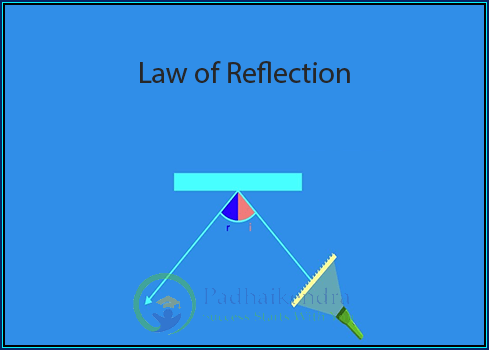The laws of reflection describe how light behaves when it interacts with a reflective surface. These laws govern the angles at which incident light rays and reflected light rays interact with the surface.
First law of Reflection
The first law of reflection states that the incident ray, the reflected ray, and the normal to the surface at the point of incidence all lie in the same plane. In other words, the angle of incidence (the angle between the incident ray and the normal) is equal to the angle of reflection (the angle between the reflected ray and the normal).
Second law of Reflection
 The second law of reflection states that the angle of incidence is equal to the angle of reflection, measured from the normal to the surface.
The second law of reflection states that the angle of incidence is equal to the angle of reflection, measured from the normal to the surface.
Together, these two laws describe how light interacts with reflective surfaces, and they are fundamental to understanding many optical phenomena, such as the formation of images in mirrors and the behavior of light in lenses and other optical instruments.
These laws can be summarized by the equation:
θi = θr
where:
θi = angle of incidence
θr = angle of reflection
The laws of reflection apply to any smooth surface, such as mirrors or highly polished objects. When light strikes the surface, it is reflected according to these laws. The incident ray represents the path of the incoming light ray, while the reflected ray represents the path of the light ray after it reflects off the surface. The normal is an imaginary line perpendicular to the surface at the point of incidence.
These laws are fundamental in understanding the behavior of light and are utilized in various applications, such as in designing optical systems, analyzing the reflection of light in mirrors, and understanding how light interacts with different surfaces.
It’s important to note that the laws of reflection assume that the reflecting surface is perfectly smooth and the reflection occurs at a single point. In reality, surfaces may have imperfections or roughness that can cause diffuse reflection, where light scatters in multiple directions rather than reflecting in a single direction according to the laws of reflection.
The laws of Reflection FAQs
The laws of reflection describe the behavior of light when it reflects off a surface. There are two main laws:
The incident ray, the reflected ray, and the normal to the surface all lie in the same plane.
The angle of incidence is equal to the angle of reflection, measured with respect to the normal.
The incident ray refers to the path of light before it strikes a reflecting surface. It is a straight line that represents the direction of the incoming light.
The reflected ray is the path that light takes after it bounces off a reflecting surface. It also travels in a straight line, obeying the laws of reflection.
The normal is an imaginary line perpendicular to the surface at the point of incidence. It is used as a reference to measure the angles of incidence and reflection.
No, according to the laws of reflection, the angle of incidence and the angle of reflection are always equal. They are measured with respect to the normal and are equal in magnitude but opposite in direction.
No, the laws of reflection apply to all types of surfaces, whether they are smooth, rough, or polished. However, the nature of the surface can affect the quality of the reflection, with smoother surfaces producing clearer and more predictable reflections.
The laws of reflection explain how mirrors create mirror images. When light reflects off a mirror, it follows the laws of reflection, resulting in an image that appears to be behind the mirror at the same distance as the object is in front of the mirror.
Yes, the laws of reflection can be applied to curved surfaces as well. However, in the case of curved mirrors, the angle of incidence and the angle of reflection are measured with respect to the tangent to the curve at the point of incidence.
No, the laws of reflection apply to all types of electromagnetic waves, including visible light, infrared, ultraviolet, and even radio waves. The behavior of these waves when they reflect follows the same principles.
Yes, the laws of reflection can be observed in various everyday situations. For example, when light reflects off a mirror, when sunlight reflects off a smooth surface like water, or even when you see your reflection in a glass window. These instances showcase the predictable behavior of light as it follows the laws of reflection.
 The second law of reflection states that the angle of incidence is equal to the angle of reflection, measured from the normal to the surface.
The second law of reflection states that the angle of incidence is equal to the angle of reflection, measured from the normal to the surface. 




